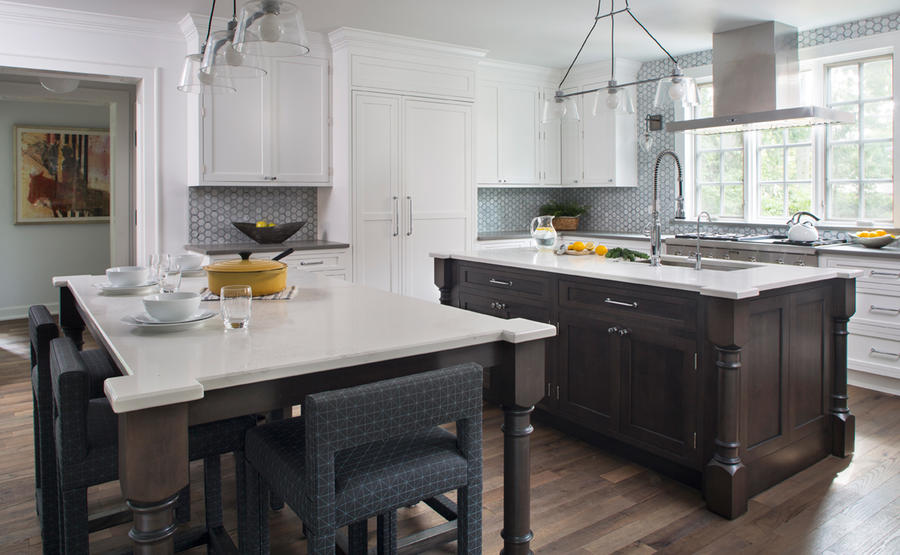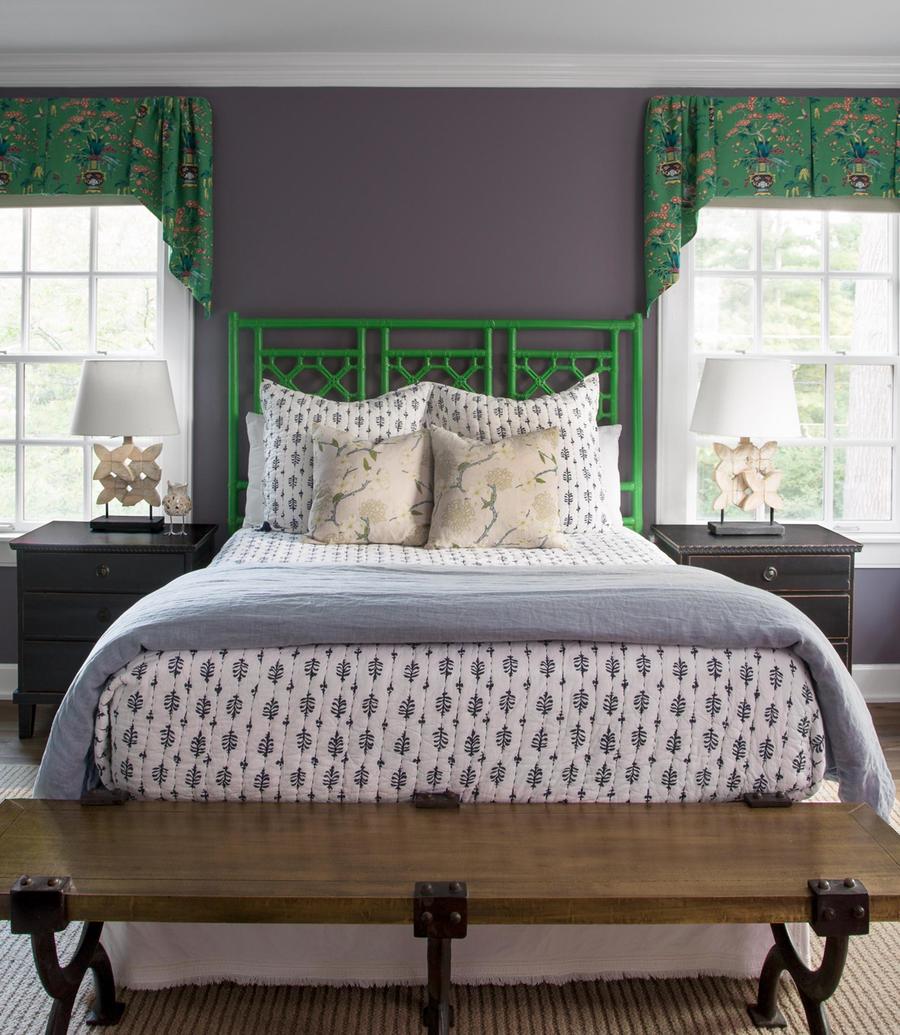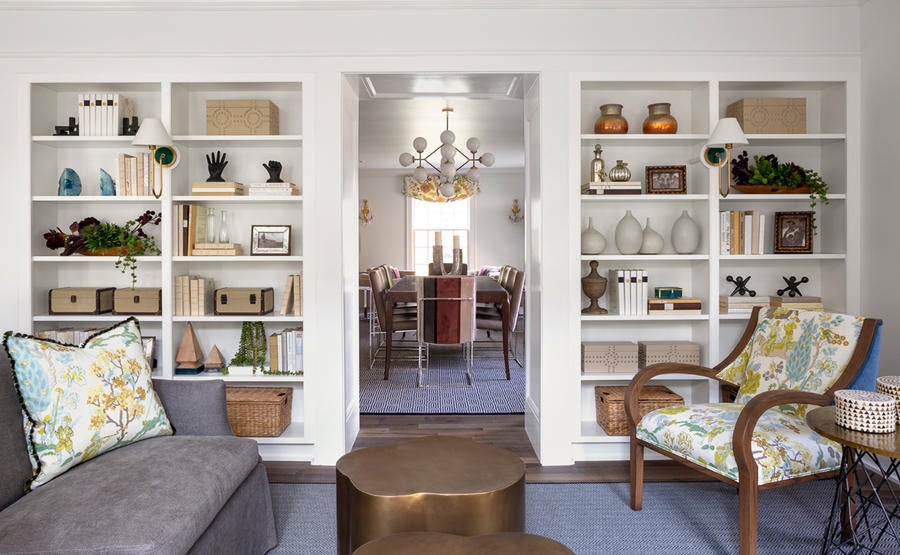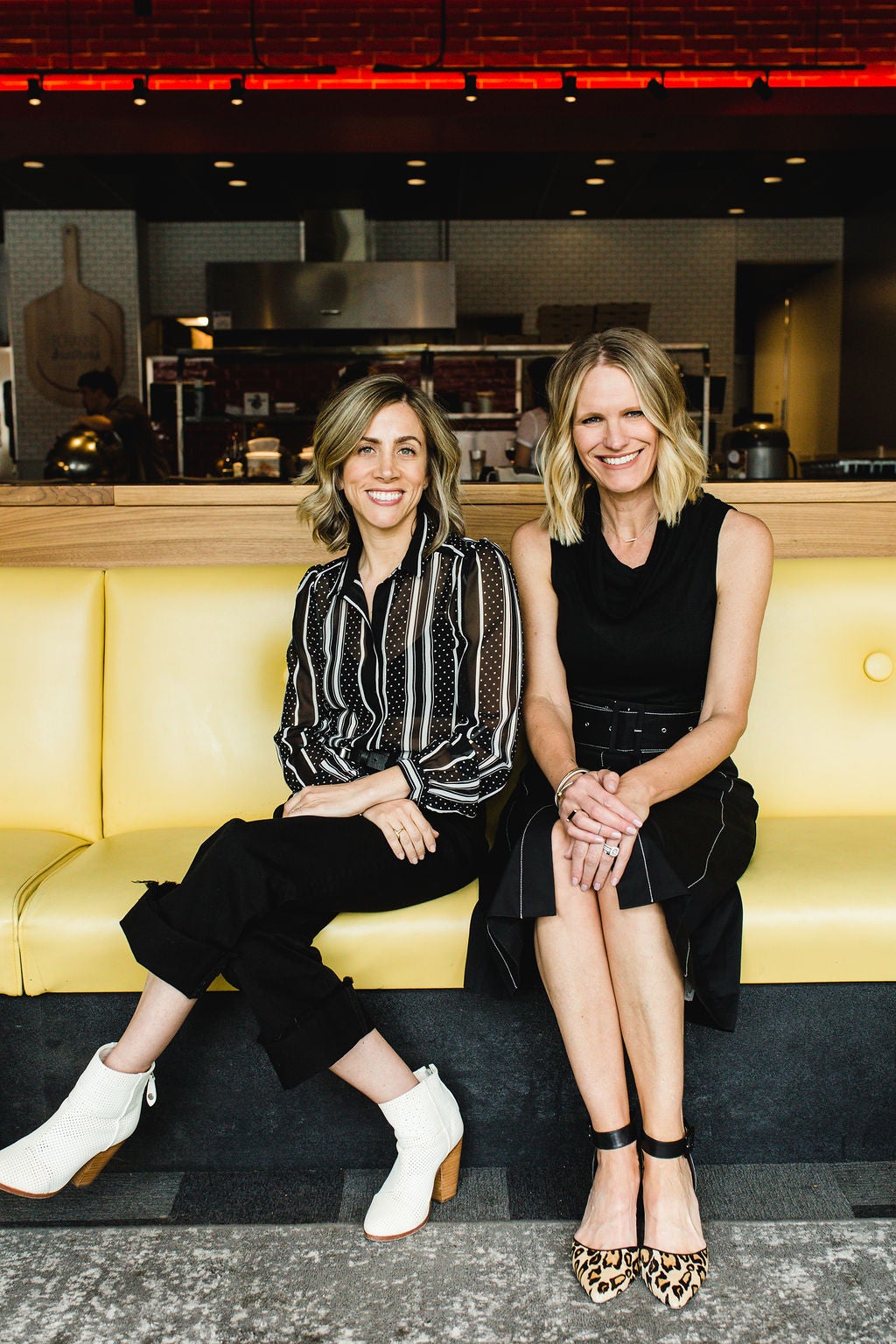The 50 States Project is a yearlong series of candid conversations with interior designers we admire, state by state. Today, we catch up with Littleton, Colorado–based designers Miranda Cullen and Devon Tobin, who were introduced by a client and founded Duet Design Group in 2011. In addition to sharing a recent project for repeat clients, they tell us why they formed a second design firm to focus on quick-turnaround projects, how they avoid scope creep, and about the foundation they founded to create safe spaces for children in need.
Can you tell me a little bit about how the two of you met and started your firm, and what you wanted to create?
Miranda Cullen: We met about eight years ago. What’s ironic about the whole thing is that the very first project we ever worked on together, Devon started and I finished—before we even knew each other! I had recently left a firm and started my own when we were introduced by a client. Devon was working for a company where the client didn’t love the principal, so the client hired me to finish what this other company had started. When all was said and done, the client said, “You should really meet Devon. You guys would be great together.”
The client introduced us shortly thereafter, and we got to know each other. It’s like dating, trying to figure out where she came from and her strengths and weaknesses, and [how they compared to] mine. We realized that we were the perfect complement to one another—so in the middle of a recession, in 2011, we started Duet Design Group. It is now a booming business, and we have since started a second company called Inside Stories by Duet Design Group, in an effort to be able to really grow our firm.
What’s the difference between the two businesses?
Devon Tobin: With Duet Design Group, we’re the points of contact and manage all of the projects that go through the firm. About three years in, we realized that we can’t really grow our firm operating this way—there are only so many hours in the day! The two of us were like, “We don’t really want to do anything any differently, because right now we both love every aspect of what we’re doing.” At the same time, we had to start turning work away. People were calling us and saying, “We love your work and we want you to do our houses,” and we just didn’t have the capacity to take on all of those projects. Based on that need, we created a scalable firm with Inside Stories.
How does that work?
Cullen: We have five amazing full-time interior designers that do the designs for Inside Story. We still design as a team, under one roof, so the designs are still very collaborative, but you have a project lead—one of these five designers—who is your contact. As a result, we’re able to charge less for that service. In a firm of our size, Devon and I are the most expensive people, but when you hire people, even very qualified designers, you have a little bit more leeway on price point. This company’s [mission was] to make sure that designers are compensated more than fairly, as well as offer a service to the public that they appreciate and that’s a bit more affordable for them.
The projects range [in size]. Our minimum is $375, and it goes all the way up to whatever it is that you want. They’re able to turn the project around much quicker because the service is faster, but you’re still having this great experience interacting one-on-one with the designer. We tried the design-in-a-box [model], but it didn’t work for us. An interior design service that is specific to you [requires] that your designer [interact] with you in your space to figure out the best way to design it aesthetically and functionally. These e-design platforms are really great if you just want great but sort of regurgitated design—and for some people [that works because] they just don’t care. For us, that personalized service is our bread and butter, so we’re trying to do that on an affordable level.

Is there a limit to the service with Interior Stories, or is it the same experience a client would get working with Duet Designs, just with different designers?
Tobin: It tends to not be as full service and white glove as Duet Design Group. We find that right now, Duet Design Group is doing custom homes and huge remodels—the client is looking for a pretty high-end design, and their spend is a lot more. And with Duet Design Group, we’re pretty rigid about our process, and we’re pretty rigid about the types of projects that we take—if you don’t fit into our box, we can’t take projects.
Cullen: With Inside Stories, people want more flexibility. We have a three-hour minimum, all the way up to finishing the whole house for you, but you don’t have to necessarily have us do all of it. If you want us to do a portion of your project, we can do that. It’s just a more flexible service and a less expensive rate.
So for Inside Stories, you’re billing hourly for design time. How do you price product?
Cullen: For designs, we cover the designer’s time to design and our overhead; we give the clients options on the Inside Stories side, so if they want to purchase goods from us, they can. If they just want to take the design that we’ve curated for them and shop on their own, we give them that opportunity. If they do purchase from us, we buy direct from manufacturers at wholesale prices and mark up from there; we don’t buy from middlemen like showrooms. That allows us to be a profitable business.
How many people are on your team to make this all happen?
Cullen: There are nine of us on the Duet Designs side. On Inside Stories, we have five full-time designers and just hired a general manager.
You said that for Duet Designs, there’s a certain kind of project that works for you. What is that?
Tobin: Essentially, it equates to minimum spend. We have a minimum design fee that we require, and then we have a minimum purchase of goods. It’s different, because on the Inside Stories side, we’re able to cover overhead and make money on the time billed, because that business model is based on quantity—the more designers we have, the more money the company generates. On the Duet Designs side, our time billed literally just pays for our time; we have to sell goods in order to be profitable.

Devon is a LEED Green Associate. How much are you focusing on sustainability and green living in the spaces you’re creating?
Tobin: We let the client drive that piece. We have clients for whom it is not very important to them, and we’ve had a couple of clients where it has been very important, and we curve our design to accommodate the client’s needs. There was one residential client who was like, “I want everything to be as sustainable as possible—the custom pieces, finishes—and all-natural or recycled products.” And let me tell you, that was an intense go to furnish a 10,000-square-foot house with all of those requirements.
Are there enough resources available to do that, or is that a struggle?
Cullen: There are, but there is a price tag that comes attached. We had to do a ton of research. When we needed a custom piece of furniture made, we had to find out who has 5 percent waste when they’re doing their finishing. A lot went into that, and we were able to accomplish it—and it was certainly nice that the clients were like, “Whatever the cost is, we’re willing to pay it in order to go this route.” But it is a costly venture, and to be blunt, most clients just don’t want to pay it.
We also had a multifamily project that was looking for their LEED green points ... to get all of the concessions the city gives you for those types of things. But in the eight years we’ve been in business, we’ve had something like 300 clients—and we’ve had two projects that have required it.
What is the percentage upcharge to be that thoughtful about it?
Cullen: It’s double. Especially when you’re doing custom stuff.
How many projects are you working on at a time?
Tobin: At any given point, we probably have eight to 10 going on, and then with Inside Stories, there are a lot more. We’re very upfront with our clients about our availability—some of them are willing to wait for us and others are not, which is why we have Inside Stories. It allows us to be moms and wives as well as business owners and interior designers. We’re trying to figure out and find that balance for ourselves so that we feel successful in all facets.
What is the next thing you want to figure out?
Cullen: The focus this year—which is an awesome problem to have, obviously—is to be very thoughtful about the projects that we’re bringing in, to make sure that our timelines fall within those clients’ timelines, as well as pacing our work, in order to make sure we’re filling our year properly.
What’s awesome is that based on the amount of revenue that we need to bring in for 2020, we only need one more project to fill the books for this year, and it’s only February.
Congratulations! That’s huge.
Cullen: I know. That was a really fun realization that we just had when we sat down a week and a half ago to lay out the year, review what we’ve got in the books and what we’ve got coming up.
What is the secret to your business success? You started during a recession, which is not exactly the best time to start a design business. How have you made it work, and so well?
Cullen: Both of us went to interior design school and are passionate about great design, but we also both have this equal passion for running a really great business. We are responsible on both ends of things—to our employees, as well as to our clients.
When we first started working together, we officed out of the guesthouse on Devon's mom’s property in Cherry Hills Village. It was free rent, which was perfect in the beginning, but we needed to hire somebody within a year and couldn’t have employees there, so we started looking for space to rent. We found this space in downtown Denver and signed a lease. And then there was this pivotal moment where we were sitting in that office with three employees, and Devon turns to look at me and goes, “What if this doesn’t work?”
I was like, “Failure is not an option at this point.” Like, we will figure out a way that this is going to be successful. My husband was a stay-at-home dad with our kids, so I was the only source of income. ... And to this day, we’ll say, “Failure is not an option.”
When we started Inside Stories—as many times as we tried to figure out an easier way to do a service and fell down and failed at it, you have to get back up. You take that information and you do it differently next time. I think that piece of us, that resilience, is what has gotten us to this point. We are lean. This firm grew up in the recession, and our families depended on our success. We figured out how to do it as efficiently as possible.

Are there some things from that traditional design firm model that you had to get rid of to make the business work better?
Cullen: Oh, yeah, tons—like, we did everything opposite. The biggest thing, by and large, is that we are not an hourly design firm unless our clients request it. We are fixed fee. We make sure that our scopes of work are very specific, and we don’t allow scope creep. We tell our clients, “We will guarantee this pricing if you stick within these parameters.” With that comes high efficiency, because if we can’t do it in the time that we’ve said, we lose money. We say that our approach is very in-the-box, but our designs are very much out-of-the-box. We are not the design firm that is going to take you out shopping for the day, wine and dine you, and spend eight hours on your dime to be your bestie. We just are not that. We are business owners, and the people that come to us are very appreciative of that. We also are fine saying that our process is not for everybody—some people really do want that companionship, the validation of someone holding their hand through the entire process, and that is totally fine. It’s just not what we do.
How are you getting new business? How do people find you?
Tobin: Mostly word of mouth and Google. We’ve never had a marketing strategy before, but we’ve just hired a marketing manager this year to help us be strategic about our company’s placement as we’re trying to grow Inside Stories. We need those leads to reflect that, so he is working in conjunction with our creative coordinator on the visual stuff to figure out a strategy. He’s only been with us for a month, but his knowledge of Google Analytics has really increased our [profile], and our phone is ringing off the hook.
Is it just adjusting how you’re positioned online?
Tobin: How we’re positioning online, how we’re searchable. We’re going to be creating a blog and just sort of getting our name out there a bit more.


The two of you also created a foundation. Can you tell me about that?
Cullen: We are both firm believers in giving back, and even from very young ages, we were volunteering with our families. We decided when our company was very young that we wanted to make sure that we were giving back. In true Miranda and Devon form, we were like, “Let’s create a foundation. We can totally do that—it shouldn’t be too hard!” But oh, my goodness, creating that 501(c)(3), the Duet Design Group Foundation, was a two-year process. We definitely did not know what we were getting ourselves into.
What work have you done so far?
Cullen: Devon’s mom, Lezlie [Goldberg], has always had a role with our company. When we first started, she was helping us place orders and expediting; as the company grew, we started employing different people to do those positions. We approached Lezlie and said, “We don’t want this foundation to be just a little thing. We want to be able to make a difference in our community, and we would really love for you to take your time and efforts to grow this foundation and help us achieve our goals.” About this time last year, she began to focus on the foundation. She presented the business plan for the next three to five years to us yesterday, and it is pretty intense!
We’re going to be spending a lot of time making sure that we’re working with the right partners, doing the right types of projects, and most importantly, making sure that our companies are fruitful and that we are providing amazing environments for our employees, our families, and that we’re able to help those that are a little less fortunate and down on their luck. Honestly, some of these kids that we’ve been helping have had really crappy lives; for us to come in and be able to help create environments for them to heal, we are finding great success in that.

How do you decide what projects to take on?
Tobin: The goal for this year is to home in on what the right type of projects are. We’ve discovered that we really want to be involved in creating healing environments for families with kids, and for kids that don’t have families—interim housing, or a halfway house type of environment. Creating spaces that they’re proud of gives them a reason to wake up every morning and be proud of who they are and how they’re living.
Cullen: Our first venture was two years ago—we did a project called Lincoln House for Third Way Center. When we first went into this really dilapidated building, I left in tears. I mean, I wouldn’t even sit on the sofa in the group room. I couldn’t believe that there were children in there trying to heal—you’re trying to build up their self-esteem, but they live [in such challenging environments]. These nonprofits are focused on having a warm place for these kids to reside, and I guess my naivete was that I didn’t realize how dire [many people’s circumstances are]. That was a big reality check. We partnered with them to do some work on that old building, renovating a couple of their units. You would think we would learn to take baby steps, but it was a very aggressive project.
Then this past summer, we partnered with the nonprofit Brent’s Place that houses families with kids with terminal illnesses or illnesses that require them to be very close to the children’s hospital. We helped them furnish some multifamily units to house some of these families. Then they had a family that had moved here from New Mexico to be closer to the hospital because their youngest of three children had this horrible cancer; they had been living in Brent’s Place for almost six years; the father had been deported, and the mom was trying to raise these three kids all by herself. We partnered with the Caruso Foundation, which bought a home in a trailer park for this family. They fixed it up, and then we came in and furnished the entire place for them over Christmas. My daughter’s soccer team “adopted” the family for Christmas, so we also provided gifts for all of them. To see that family walk in—they had a teenage daughter who is my kid’s age, and she was like, “I’ve never had my own room. This is amazing.”
That’s astounding.
Cullen: We’re trying to bite off smaller projects like that so that we’re not running ourselves into the ground doing all of these things, but I’m telling you, I said to Devon, “I’ve got, like, maybe 10 years left in this Duet Design Group thing, and then I want to do this foundation 24/7.” It’s such a rush to be able to see how you’re [making an impact] with something that comes so naturally to us. We spent 40 hours all-in, designing, shopping and installing—and to spend 40 hours of your time, and to see how impactful that is for a family that has been affected by a horrible disease is pretty inspiring.
To learn more about Duet Design Group, visit their website or find them on Instagram.
Homepage photo: Devon Tobin and Miranda Cullen | Coryn Nelson Photography




























